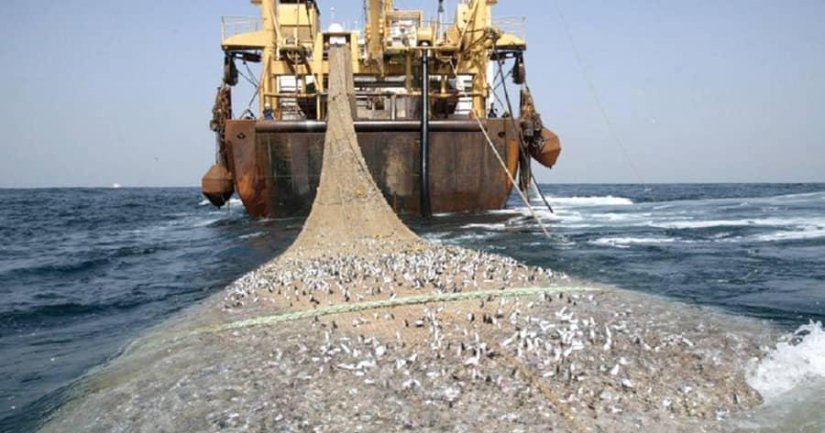Ghana’s marine fishery directly and indirectly generates remunerative employment for many people in the coastal communities.
Despite its contribution to the nation’s economy, the sector has over the years been experiencing a never-ending decline of stocks.
One of the reasons for the continuous decline of fish stocks has been attributed to ‘Saiko’– an illegal practice where industrial trawlers sell their “unwanted” catch to local canoe owners on the high seas.
‘Saiko’ is illegal under Ghanaian fisheries legislation, attracting a fine of between US$100,000 and US$2 million. Notwithstanding, the minimum fine increases to US$1 million where catches involve juvenile fish or the use of prohibited fishing gear.
This practice has a far-reaching impact on the sustainability of the fishery sector, a total deviation from the target fourteen of the Sustainable Development Goals which is Sustainable Fishing.
Beyond the urgent concerns to totally put an end to “Saiko”, artisanal fishers are left with no option but to engage in other illegal practices to earn their livelihood.
As the saying goes, “when fishermen cannot go to sea, they mend their nets”, this has always been the normal routine for artisanal fishers.
It was a bright Thursday morning in Elmina, a historic fishing community in the Central part of Ghana. Many fishermen are embarking on what has become a routine – mending and fixing their nets for another fishing expedition when I visited.
Forty-Six year-old fisherman, Mr. John Botse, has been in the fishing business since the 1990s, more than half his life here in Elmina.
Fishing is the only business trade he knows. Mr Botse worriedly expressed acerbically that, “I have been in this fishing business since 1990, and our major problem in this business is the issue of ‘Saiko’.
He added, “it takes tons to go for fishing, if the catches are not profitable, we end up incurring debts. The authorities have turned deaf ears to our demands for action.”
The worrying situation according to the fishermen there have compelled them to employ many ways both accepted and unacceptable practices.
“Therefore, we try any possible way, the use of light to bring something home to cater for ourselves and families”, he revealed.
Though he admitted the practice is unacceptable, Mr Mensah continued that the situation is the only best option he can explore to survive.
“It is illegal to fish with light and chemicals in Ghana, we know the harm associated with it but “Saiko” leaves us with no option. Light and chemicals enable us fish all year round against all expectations”, said a 20 years experienced Elmina-based fisherman.
According available literature, light attraction is the technique of aggregating fish by artificial light; and light fishing is the process of fishing the attracted fish by hooking, gill-netting or by any other gear. The light source may be by means of a fire torch, pressure kerosene lamp, gas lit lamp and battery or generator assisted incandescent lamp.
Currently the light fishing operations in Ghana use mainly the purse seine gear with a small size generator powering the incandescent lamp.
The species they target are mainly the small pelagic fish. Pelagic fish are fish that spend most of their time swimming in midwater and the surface of the water. Some of the most important groups of fish caught with light attraction are Small pelagic fish of the herring group like herring, and sardinella. Mackerels, young fish of the bonito and tuna family and the smaller horse-mackerels are also targets.
This development has generated some conflict between the inshore and the canoe operators. The reduced catches over the past couple of years, especially with the canoe fishers, have caused them to accuse the inshore operators of light as the reason for their declining catches.
The small pelagic industry in Ghana depend on the surface shoaling of the pelagic species during the cold season or period of water instability, which occurs from mid-June to September when water surface temperature is below 25 degrees celcius, this is according to a 2004 report by the Marine Fisheries Research Division (MFRD) on the observations of commercial light fishing operation in Ghana.
The report continues that around September to December was the period when light fishing was most conducive because at these times the fish appear in scattered formation and light would be needed to aggregate them.
But the situation is different now, both Botse and Mensah and other fishermen today are now doing it (light fishing) all fishing year round.
In an aquatic environment, fish respond to visual stimulation by moving towards a light source to form a cluster, mostly to feed and spawn and it becomes easier to catch them through that.
Fishing with light attracting-equipment spurs on overfishing which ejects a weighty threat to conservation of marine resources and biodiversity.
The way forward
The 2020 edition of the State of World Fisheries and Aquaculture Report reiterates that in places where fisheries management is not in place, or is ineffective, the status of fish stocks is poor and deteriorating – a clear picture of Ghana fisheries sector.
The Report suggests that, “the only solution to ensure sustainable fisheries is to adopt mechanisms that would support the effective implementation of policy and management regulations.”
Ghana’s fisheries sector is regimented by series of laws enacted by parliament, fisheries regulations and their amendments, as well as structures of governance.
In spite of all their restraints, Ghana’s fish stocks are rapidly diminishing largely as a result of illegal fishing practices.
Therefore, government support to enforce the regulatory measures is a key element to curb illegal fishing in Ghana.
Report by Eunice Osei | SOA Ghana Fellow
This report was supported by Sustainable Ocean Alliance Ocean Solutions Microgrant
